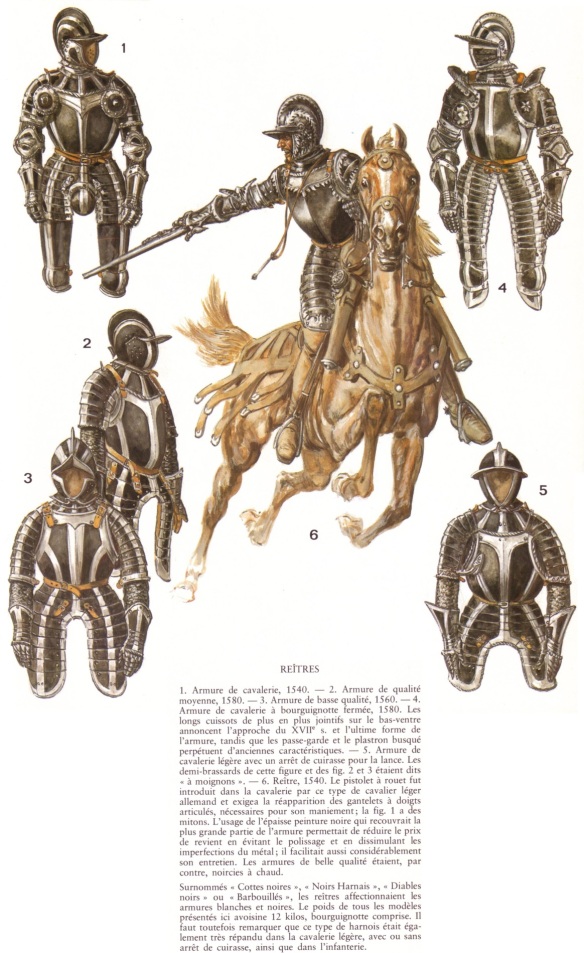Equipment of lancer and reiter, also from Wallshavsen Art Militare a Cheval, 1616.
While the French and Spanish stuck with the lance as the weapon of choice of their heavy cavalry, the Germans changed over to pistols. These reiters (or schwartzreiters because of their habit of wearing black armour) became the usual sort of mercenary German horse hired by the various combatants in the wars. They developed the caracole, a system whereby a deep formation of pistoleers could deliver a continuous barrage of pistol fire against a stationary target (usually a pike block) – each rank firing in turn then moving off to the rear to reload. Each man carried up to three pistols, two in holsters and one in the right boot.
The Germans developed a new kind of cavalry armoured in a breastplate and high, heavy leather boots, and armed with three wheel-lock pistols. This new mercenary light cavalry, called Schwarzreiters or ‘black riders’ because of their black armour and accoutrements, attacked enemy formations using the revolving tactics of the caracole.
To execute the caracole, these reiters, as they were soon called, trotted toward their enemy in a line of small, dense columns, each several ranks deep and with intervals of about two horses’ width between files. In a tactic reminiscent of the Parthian shot, the reiters fired their three muzzle-loading pistols, then swung 180 degrees and filed to the rear to reload. Usually the caracole tactic was employed before a general advance as a means of disrupting enemy cavalry and infantry formations. But the time and awkwardness of reloading while mounted meant the caracole was a very difficult manoeuvre to carry out effectively, and, like light cavalry from the classical and medieval period, it was easily disrupted by an enemy heavy cavalry countercharge.
As the wheel lock’s distribution and production passed through Germany from northern Italy to the rest of Europe, the German Reiters (riders, or horsemen) recognized its potential and developed new tactics to exploit it. The wheel lock saw extensive use by all belligerents during the Thirty Years’ War, and demand for and the manufacture of wheel-lock pistols expanded rapidly during the period. The wheel-lock mechanism transformed the pistol into a compact, practical weapon suitable for mounted troops. The new pistol could be carried loaded, ready for instant use, and significantly extended the killing range. The advent of the wheel-lock pistol made possible the caracole, a military maneuver in which close-order waves of sword and pistol-armed cavalrymen rode within close range of infantry, fired their pistols, and then broke away, allowing successive waves to follow. The massed fire of the caracole proved effective against densely packed squares of pikemen and other formations of ground troops. Although short-ranged owing to their relatively short, smoothbore barrels, the wheel-lock pistols did reach significantly farther than the pike, and massed fire compensated for the pistol’s inaccuracy. The wheel lock also gave a similarly deadly advantage when used against cavalry armed conventionally with sword and lance.
German horseman with wheel lock Faustrohre pistols, about 1600.
The pistol emerged triumphant; its advantage was that it could be manipulated with one hand, the other being used to control the horse. It was not unknown for a pistol to fail to go off, which was why every man carried between two and six. Training to use a pistol also took less time than teaching a man to use the heavy lance, and smaller horses could be used by pistol-carrying units, as their armour was much lighter. On the other hand, the knights’ armour, though improved and strengthened, could no longer withstand the increased penetration of the firearms deployed by the infantry and light cavalry. Towards the end of the sixteenth century, heavily armoured cavalrymen stopped using horse-armour, and reduced their own, becoming cuirassiers. The tactics of the reiters were adopted by all cavalry forces. Owing to improved weaponry and training, the depth of battle formation decreased first to ten lines, and towards the end of the century to six or seven. Shallower formations using the same number of men meant wider fronts, which had to be controlled by discipline and training. The cavalry of the period was therefore a modern force, acting as an organized troop.
The armour used by the reiters was not uniform and could vary from just a mail shirt or cape, through corselet (often with mail sleeves), to threequarter armour. Helmets ranged from simple ‘iron-hats’ to burgonets or morions. They were armed with large pistols of the faustrohre type (faust – hand, rohre – barrel), thus named because they were as well suited for clubbing as for shooting the enemy. It had a barrel length of about 50 cm/20 in, weighed about 3 kg/6.5 lb and fired a 30 g/1 oz lead ball. The pistol could be aimed accurately from approximately 20 paces; unaimed fire could be effective up to 45 m/50 yds. However, it was effective against the most heavily armoured opponents only at a few paces.
